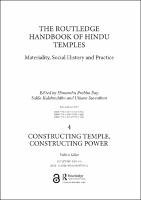Chapter 4 Constructing Temples, Constructing Power
Proposal review
Abstract
There is a dearth of archaeological vestiges for Hindu temples prior to the 6th century in the Tamil-speaking South, although we know through literature and epigraphy that they were built at least by the early 5th century. This may be explained by the fact that these monuments were made of perishable material which did not survive the centuries. However, many temples scattered around the holy Kaveri river are still extant because many of them were reconstructed in stone, a long-lasting and prestigious material, in the 10th century. Analysing the epigraphy of some sites of this region, Valérie Gillet attempts here to outline different processes lying behind the reconstruction of those temples. She investigates more particularly the site of Govindapputtūr, where an important character emerges in the epigraphy as a key figure of the locality and explores how the endeavour of reconstructing a temple in stone appears to be, besides being an act of devotion, a process to gain and establish one’s power.
Keywords
Tamil epigraphy; Hindu stone temples; Kāvēri river; Govindapputtūr, reconstructionDOI
10.4324/9781003097709-6ISBN
9780367563158, 9781032380223, 9781003097709Publisher
Taylor & FrancisPublisher website
https://taylorandfrancis.com/Publication date and place
2023Imprint
RoutledgeClassification
Hinduism
Religion and beliefs
Society and culture: general


 Download
Download